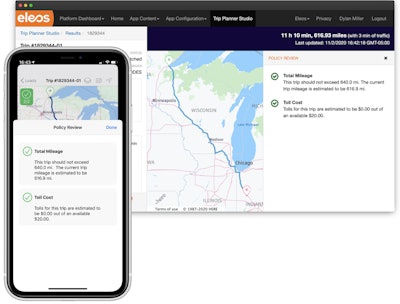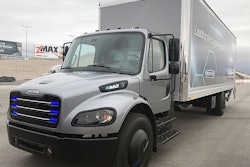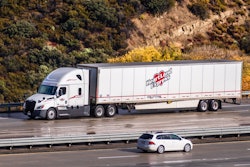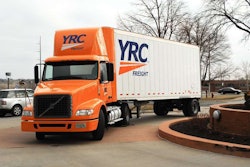Technology makes it possible for motor carriers to put tight controls on load planning and routing and to keep close tabs on driver safety and performance. The downside of having such high levels of virtual control is that drivers can feel micromanaged and may choose to work elsewhere.
That’s why many fleets are looking for ways to strike a harmonious balance by using technology for operational control while giving drivers more flexibility and an overall better work experience.
Several announcements this week from technology suppliers highlight a trend of new tools that can help restore balance to both sides of the equation.
Flexible trip planning
Eleos added new route planning tools to its customizable mobile driver workflow app. Fleets that use the Eleos platform create their own company-branded version of the app.
 Eleos has added new trip planning tools to its mobile app that give fleets greater control over load profitability and drivers more flexibility in trip planning.
Eleos has added new trip planning tools to its mobile app that give fleets greater control over load profitability and drivers more flexibility in trip planning.Fleets now can specify on a per-load basis a maximum for out-of-route miles and toll costs. If a driver adds a stop in trip planning that results in a route that exceeds the maximum, the app will alert the driver to change the route plan to comply.
The new tools, Max Miles and Max Route, capture drivers’ intent to help fleets better plan and protect their load profitability by setting the maximum limits.
Representatives from Eleos gave CCJ a demonstration of the new trip planning features. When a driver plans a trip in the app, their plan is checked against their company’s active policies for the load. Results are displayed to the driver before starting the trip.
As part of the workflow, drivers can enter a reason and get approval to violate a policy for miles or toll costs.
Drivers start with a dashboard of “load cards” that contain relevant load information such as customer origin and destination. Fleets typically send these load assignments to the app through an API integration with their transportation management system (TMS).
When a driver taps on a load card, the app opens a trip planning screen that shows the planned route. Drivers see locations on the route plan where hours of service will expire. From this map screen, drivers can adjust their departure time and add stops and through points, among other options.
The screen notifies drivers of locations with difficult maneuvers based on truck and street-level data that drivers can route around if warranted.
Once drivers start to execute a route, the Eleos system makes recommendations based on real-time traffic conditions. If the planned trip exceeds the set thresholds at any point — due to a reroute to avoid traffic congestion, for example — the driver will see an indicator and an explanation.
Fleet managers are alerted through a “trip planner studio” screen in Eleos’ user web portal or within the fleet’s TMS through integration. From the web portal, the route used for policy evaluation includes edits made by the driver — such as planned rest stops — as well as estimated mileage driven as part of previous stops, including out-of-route deviations that occurred while driving.
Fleets using the Eleos platform include USA Truck, Prime Inc., Navajo and Knight-Swift Transportation. The platform gives drivers a unified mobile experience, both on Apple or Android in-cab and drivers’ personal devices, through integration with fleets’ ELD and back-office systems.
Putting tablets in trucks
Platform Science announced it has selected Samsung’s Galaxy Tab Active line for its enterprise fleet management system to support efforts of its fleet customers to improve the in-cab experience for drivers.
 Werner is planning to add new driver trip planning features to its Edge Connect telematics platform.
Werner is planning to add new driver trip planning features to its Edge Connect telematics platform.Werner Enterprises is implementing Samsung tablets and Platform Science’s RPM functionality in nearly 8,000 trucks for its Edge Connect telematics platform.
Platform Science says that its Remote Platform Management (RPM) system works with the rugged Samsung devices to support fleets’ custom mobility needs. Fleets are able to deploy applications through RPM and use it to integrate and share data between apps used on devices, with their back-end systems and with vehicle sensors.
“The fleets we’ve partnered with require safe, ruggedized equipment for drivers’ day-to-day activities, which is how Samsung got selected as the tablet of choice, coupled with RPM,” said Jake Fields, co-founder and chief technology officer for Platform Science.
Samsung Galaxy Tab Active tablets are purpose-built for transportation and have a wide range of security features built to work with Platform Science technology.
Free telematics
Motor carriers and fleets of all types have opportunities to deploy driver-friendly telematics platforms offered to them by insurance companies.
 Azuga’s fleet management system has a mobile app that shows drivers a scorecard with incentives.
Azuga’s fleet management system has a mobile app that shows drivers a scorecard with incentives.Azuga reported a 60% increase in sales of its telematics hardware and software to commercial fleet automobile insurers between October 2019 and September 2020. Azuga’s insurance customers that resell the technology to automobile fleet clients reported a 20% reduction in loss frequency.
Fleet owners plug the Azuga GPS Tracker into the OBDII port in each vehicle and use the Azuga application to monitor vehicles and driver behavior. Managers can see vehicle service warnings, how fast a vehicle is traveling and when and where “hard braking” occurred. They also can block smartphone distractions such as texting, calls and app use.
After receiving Azuga devices from Philadelphia Insurance, Misericordia University, a private college in Dallas, Pennsylvania, explained to drivers that management would be tracking their locations and speed.
“On that basis alone, people became more conscious when operating vehicles,” said Bob Zavada, director of campus safety and security.
Various departments at the college are using Azuga’s web portal system to track vehicle locations and detect unauthorized use.












